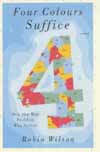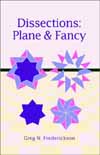book review
Many people, when they look back, can pinpoint the precise moment when their interest in mathematics was awakened - it was when they found a puzzle that intrigued them. Perhaps they now realise the puzzle was trivial or insignificant, but at the time something about it captured their imagination and started them on a path that may have led very far - perhaps even into fundamental mathematical research.
The Four Colour Theorem - the statement that four colours suffice to fill in any map so that neighbouring countries are always coloured differently - has had a long and controversial history. It was first conjectured 150 years ago, and finally (and infamously) proved in 1976 with much of the work done by a computer. The published proof relied on checking 1432 special cases, which took more than 1,000 hours of computer time.
Geometric dissection is the mathematical art of cutting figures into pieces that can be rearranged to form other figures, preferably using as few pieces as possible. You may already have come across puzzles such as the Aviary Tangram, the pieces of which can be used to form an egg, a chicken and many other shapes; but the ingenuity of the dissections shown here may still be a revelation to you, as they were to this reviewer.
George Szpiro has a most unusual day job for someone writing about the abstract world of pure mathematics. Although he first studied maths at university, he has been a political journalist now for a number of years, working as Israel correspondent for NZZ, a Swiss daily. He wrote this book at night, after the paper's deadline, and as it was being finished lost one of his closest friends in a suicide bombing. The contrast between sphere packings in three dimensions and his daytime subject material must often have struck him.
Ballet and mathematics - not a combination that you often come across, but one that works beautifully in Frederick Ashton's 1948 ballet, Scénes de ballet. From the geometric patterns on the men's tunics and the perpendicular angle of the ballerina's tutu, to the movements and positioning of the dancers themselves, this ballet is a celebration of mathematics. Ashton was inspired by mathematics, and, according to the programme notes, used a system of Euclidean geometry to choreograph the piece.
Not many books about maths have chapters that start "The dead man seemed to stare at me in a most disconcerting way." But maybe more should - this book is a highly entertaining read, crossing sound mathematical exposition with the classic Sherlock Holmes style of investigation.
Many popular books about mathematics combine elements of exposition and personal commentary, but few combine these disparate elements to the same extent as this book.
This video, aimed at students aged 16+, opens with Professor Chris Budd holding the plastic yellow duck he is entering in the Annual Bath Plastic Duck Race. Competition is stiff - there are over 3,000 contestants - but how can we predict who will win? Very few competitors have form, and it's hard to tell much about their training regimens... so is the outcome totally unpredictable?
Since the phenomenal success of "The little book of calm", publishers have been falling over themselves to produce "little books" of everything else, presumably in the hope that the essential ingredient was the littleness, rather than the calmness. Although, at 5 inches by 7¼, "1089 and all that" makes a rather big little book, and its content couldn't be further from the banalities of "The little book of calm", there is something of a "little book of mathematics" about it, with its short chapters and personal narrative.
One of Oxford University Press's series of "Short Introductions", this book is a rigorous and challenging description, by one of the greatest pure mathematicians alive (Timothy Gowers is Rouse Ball Professor of Mathematics at the University of Cambridge, and a Fields Medal recipient), of what mathematics is. Perhaps too challenging, in fact - on page 23 we are introduced to an axiomatisation of number systems, and things only get tougher. Clearly, as one of a highly intellectual series, the book is intended to stretch its readers' abilities to the utmost.
Paul Erdös is reported to have said "A mathematician is a machine for turning coffee into theorems". We may never know if he appreciated the mathematics behind the perfect dunk of a biscuit into said coffee, but we can all begin to understand the ubiquity of maths in our lives, thanks to Len Fisher's delightful book. The subtitle is "The science of everyday life", though pretty much all the content is maths with the equations (mostly) taken out. Perhaps Professor Fisher was advised that sales would suffer if they weren't, but anyone interested in the applications of mathematics to the real world will find plenty to amuse and educate.
Gerd Gigerenzer is not a mathematician or statistician per se, but primarily a psychologist, working across disciplines to understand how human beings make decisions in the face of uncertainty. What he offers here is nothing less than a prescription for how to think, how to choose, and how to live, when the information on which we base our decisions is necessarily incomplete and flawed. For example - how worried should you be if you have a positive mammogram as part of a screening programme for breast cancer, or a positive HIV test despite the fact that you are in a low-risk group?










